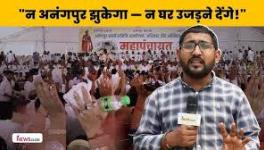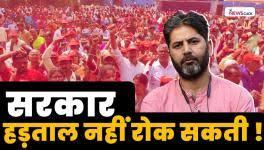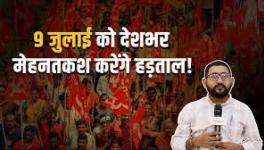Why Claims of Poverty Decline are Spurious

The media has been full of claims by the World Bank and by governments that millions of people in the Global South have been lifted out of poverty during the past three decades that saw neo-liberal economic policies. The NITI Aayog in a press release earlier this year, claimed near-zero poverty for India by 2022-23, affecting only 5% of the population.
The hard data on nutritional intake show, however, that hunger has risen greatly over the past three decades, with more than two-thirds of its rural and urban population unable to spend enough to satisfy minimum needs of calorific and protein intake; India’s very low ranking (111 out of 125 countries in 2023) on the Global Hunger Index continues, and while some health indicators have improved, others have worsened.
Those who believe the official claims say, ‘how can hunger have increased when poverty has declined?’ The question should be the opposite, namely ‘how can poverty have declined when hunger has increased?’
The information on the rise in hunger is direct, based on readily available and verifiable statistics, compared with official poverty estimates that are based on illogical and non-transparent calculation methods, rendering quite spurious the claim of massive poverty decline. The illogical method has the blessings of the World Bank which repeats the spurious claim of poverty decline.
Why is the official method illogical, and the conclusion of poverty decline spurious? Because its method has meant repeatedly under-estimating poverty lines over time, leading to a lowering of the nutritional intake that can be accessed at these poverty lines. The poor have been counted below a standard that itself has been allowed to decline; but for any valid comparison over time, the standard must be held constant.
If a school claims great success in lowering, over a period of 30 years, the proportion of failures among students taking examinations, from, say, initially 55% of all students failing to only 5% failing, we are hardly likely to believe the claim when we find out that over the same period the pass mark has been quietly lowered from 50 out of 100 in the initial year, to 15 out of 100 by the terminal year. Applying a constant 50 out of 100 pass mark, we find the failure percentage has risen.
Similarly, official claims of poverty decline carry no conviction when we see that compared to the official nutrition norms of 2,200 calories rural and 2,100 calories urban actually used to obtain poverty lines in the initial year 1973-74, in a large number of states over the next four decades the energy intake accessible at official poverty lines had declined to 1,700 calories or less and protein intake, which is highly associated with energy intake, has also declined.
According to the Tendulkar Committee poverty lines (being followed at present by the NITI Aayog), in rural Gujarat in 2011-12, the poverty ratio was 21.9% at its per head monthly poverty line of Rs 932. But we find that energy intake at this level was only 1,670 calories, while obtaining 2,200 calories required spending Rs 2,000 or over double the official poverty line, and 87% of persons fell below this level. Official poverty at 21.9% and real poverty at 87% is no mean order of difference.
In rural Punjab, the low 7.71% official poverty ratio was at a sum that gave 1,800 calories daily, while the true poverty line at which 2,200 calories could be reached, was much higher with 38% of persons falling below it.
In 2009, in rural Puducherry, the official poverty ratio was near-zero at 0.2% solely because the very low poverty line allowed only 1,040 calories per day – a starvation level, whereas the actually poor unable to reach the 2,200-calorie norm, comprised 58%. Here the official poverty line was pitched so low that below it there were no observations, since people were dead. Urban poverty similarly shows high and rising poverty compared with the decline in official estimates.
The NITI Aayog’s claim of only 5% in poverty in 2023-24, relies on the 2011 Tendulkar poverty lines price-indexed to 2023-24. Taking the highest consumption spending under the Modified Mixed Recall Period, and using the price index data in the official Fact Sheet, the poverty lines when brought forward to 2023-24, are Rs 57/69 daily per head for rural/urban areas. The food part accounts for Rs 26.6/27 and the non-food part for Rs 30.4/42 rural/urban, respectively, taking the average shares spent on food and non-food.
The food part would have bought 1.3 litres of the cheapest bottled water, with nothing left over for food (the poor do not actually buy bottled water, the example is to illustrate how paltry the food sum is).
To think that minimum non-food daily needs of a person however poor on account of rent, transport, utilities, healthcare, and manufactured goods (leave alone education and recreation) could be met by Rs 30.4 rural to Rs.42 urban per day, requires a degree of disconnect from objective reality that no rational individual can display, only the official estimators seem to be capable of it. Their so-called poverty lines are destitution-cum-starvation lines, with 6.6% of rural and 1.6% of the urban population still somehow surviving at sub-human existence levels, producing the 5% overall average claimed to be in poverty. The true poverty lines at which minimum nutrition could be obtained were at least 2.5 to 3 times higher.
In another three years at most, officially ‘zero poverty’ is likely to be claimed, because the official poverty lines would have been further lowered to a level where there will be no survivors. If an examination pass mark reaches zero, there are zero failures.
Far from declining, the share of the actually poor in both rural and urban population has risen noticeably over the past three decades. In 1993-94, the poor comprised 58.5/57% in rural/urban areas since they could not reach nutrition norms of 2,200/2,100 calories per day, while by 2004-05, the respective rural/urban poverty ratios had risen to 69.5/65%. After a large spike in the drought year 2009-10, there was a decline by 2011-12 to 67/62%.
The 2017-18 nutrition intake data were not released, but the intakes can be conservatively approximated (by deflating food spending in the later year to 2011-12 and applying the food cost per unit of nutrients) and this shows a sharp rise in rural poverty to over 80% of the population, while urban poverty remained at about the same level as in 2011-12. The full data for 2023-24 are still to be released but in view of the pandemic-induced economic slowdown and rising unemployment, the true poverty levels are likely to have remained high.
The conceptual muddle that governments and the World Bank have created for themselves, and their resulting false claims of declining poverty, is the outcome of a simple logical mistake. They first correctly defined the poverty lines on the basis of nutrition norms in the initial year, and then for every succeeding year improperly changed the definition, de-linking it from nutrition norms; and they have done this for every country.
In 1973-74 in India, the monthly spending per head required to access daily 2,200 calories in rural and 2,100 calories in urban areas, were Rs 49 and Rs 56.6, giving the respective official poverty ratios of 56.4% rural and 49.2% urban. This definition of the poverty line directly using nutrition norms was never again applied even though the needed current data on nutritional intake, has been available every five years.
Instead, these particular 1973 poverty lines were simply updated to later years using price indices as has been explained, without ever asking whether nutrition norms continued to be reached or not. To start thus with one definition of poverty line and quietly switch to another completely different definition means committing a logical fallacy, the fallacy of equivocation. This fallacious method meant that the particular basket of goods and services available and consumed in 1973-74 was held fixed – by now it is 50 years in the past – with only its cost being price-indexed to the present.
In reality, however, the actually available basket of goods and services has been changing especially rapidly over the past three decades of neo-liberal market-oriented reforms (much more rapidly than the weights assigned to different items in price indices can be changed) because of increased privatisation and market pricing of goods and services.
A basket being fixed for 50 years assumes away real trends in poverty, for whether people remain at the same level of poverty, get worse off or get better off, depends crucially on whether and in what ways the initial basket of goods and services is changed.
Historically, poverty was reduced greatly or eliminated entirely by State policies in those countries where healthcare, education, and to a large extent, housing and utilities were removed from the sphere of market pricing and were instead treated as public goods, using the budget to provide entirely free health care and compulsory free education for children, or only nominal charges were imposed.
State-financed construction of affordable low-cost housing with low rents, and nominal charges for public transport and for utilities (water, energy for lighting and cooking), freed up a larger share of the family budget for buying food, manufactured necessities and spending on recreation. Such provision of public goods was not only typical in the socialist countries in Asia and Europe; it was also undertaken in the post-World War II period in almost all the West European capitalist countries.
The converse happened, the available basket of goods and services changed drastically to the detriment of consumers, with the introduction of market-oriented economic reforms in the countries of the Global South because these measures substantially or entirely removed healthcare, education and utilities from the category of public goods and into that of market pricing. The resulting spike in these charges impacted adversely the income available to the majority of the population for spending on food and manufactured necessities, pushing more people into nutritional stress.
Unwise specific policy measures, like the 2016 currency demonetisation, or the impact of the 2021-22 pandemic-induced recession, have aggravated the poverty problem no doubt, but are not the basic causes of rising poverty, which long predates these events.
It is not a difficult proposition to substantially reduce poverty through redistributive measures. About one- tenth of India’s GDP would need to be devoted to providing adequate food for the population, basic and comprehensive healthcare, compulsory free education, employment guarantee and old age pension; for which additional taxation of 7% of GDP that the rich and super-rich can easily bear, would be needed.
Combined with vigorous implementation of the existing National Food Security Act 2013 and the MG National Rural Employment Guarantee Act, genuine large-scale reduction of poverty would result.
But an essential precondition for this lies in the realm of concepts that guide empirical work and the inferences based on them: the incorrect measurement of poverty that has been prevalent not only nationally but internationally, has to be abjured, and the false claims of poverty reduction replaced by factually and logically correct estimates.
Utsa Patnaik is a Marxian economist. She is professor emeritus, Centre for Economic Studies and Planning, School of Social Sciences, Jawaharlal Nehru University, New Delhi. Her book ‘Exploring the Poverty Question’ is in press.
Get the latest reports & analysis with people's perspective on Protests, movements & deep analytical videos, discussions of the current affairs in your Telegram app. Subscribe to NewsClick's Telegram channel & get Real-Time updates on stories, as they get published on our website.
























